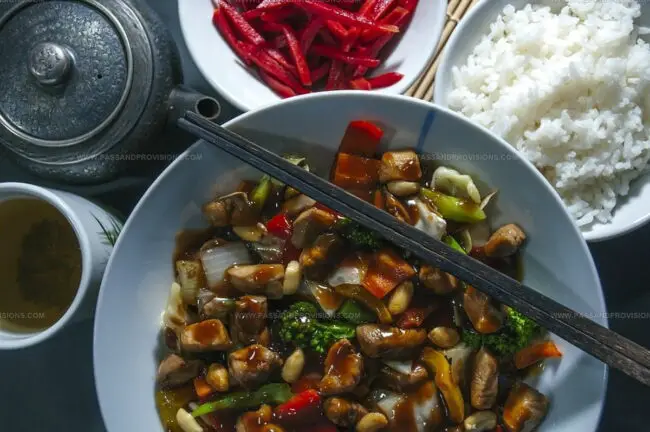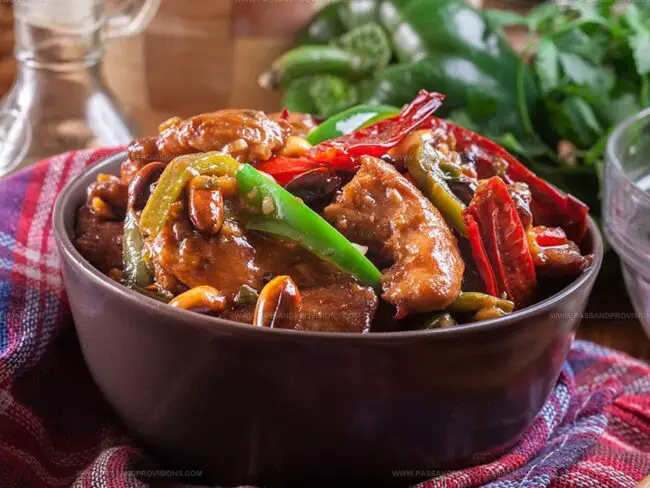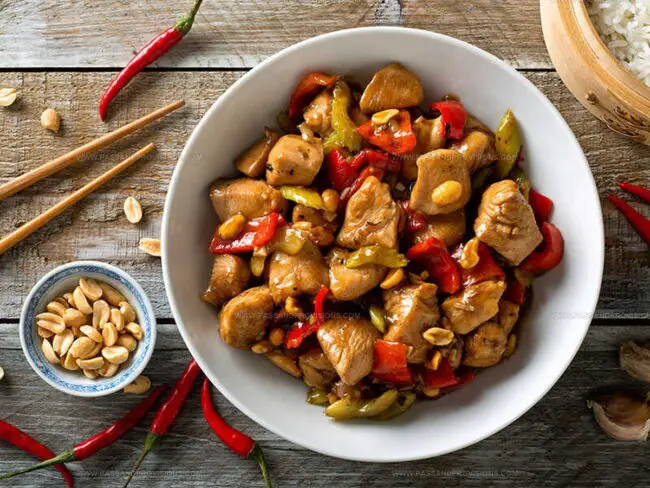What Does Kung Pao Chicken Taste Like? A Sweet, Spicy Flavor Ride
Kung pao chicken has intrigued food lovers worldwide with its complex flavor profile and rich culinary heritage.
This beloved Chinese dish originated in the Sichuan province, where bold spices and innovative cooking techniques reign supreme.
Restaurants and home cooks alike have embraced its unique combination of ingredients that create a memorable dining experience.
Spice enthusiasts and curious eaters often wonder about the sensory journey this popular meal offers.
The harmonious blend of textures and flavors makes kung pao chicken a standout in Asian cuisine.
Its reputation for delivering a satisfying balance between heat, sweetness, and savory notes has captivated taste buds across different cultures.
You'll want to learn more about this delectable dish that promises a thrilling gastronomic adventure.
Dive into the delicious details and uncover the secrets behind kung pao chicken's irresistible appeal.
What Is Kung Pao Chicken?
Kung pao chicken sits as a popular Chinese-style dish with deep roots in southwest China. Classic Sichuan recipes actually have less saturated fat compared to modern versions.
Southwest Chinese cuisine first created this spicy meal decades ago. Worldwide popularity helped spread this recipe across different cultures.
People now make kung pao chicken with personal twists based on local tastes. Crunchy peanuts often join this traditional Chinese plate.
Spice levels can change depending on someone's preference - milder versions work well for those who do not enjoy intense heat.
Unique ingredients make this dish special.
Whole dried chilies and Sichuan peppercorns create its signature flavor. American versions typically add more sweetness and extra peanuts compared to original recipes.
Chefs can adjust spice levels to match different taste buds.
Flavor of Kung Pao Chicken
Kung pao chicken brings a wonderful mix of tastes in American Chinese restaurants.
People love this dish for its balanced flavor profile that blends mild, sour, and savory notes with a hint of sweetness.
Peanuts help round out the overall taste, making each bite satisfying.
Chefs use special spices to create this popular meal that goes beyond simple cooking methods.
Kung pao chicken starts with tender pieces of chicken cooked quickly in a hot pan.
Cooks mix the meat with roasted peanuts and fresh vegetables to create a hearty meal.
Traditional recipes from Sichuan province include special ingredients like unique peppercorns, dark vinegar, rice wine, and whole red peppers.
Each component adds depth and excitement to the classic dish.
Szechuan Chicken vs. Kung Pao Chicken
Choose Szechuan chicken for bold, numbing spice. Pick Kung Pao chicken for a gentler heat with sweet, sour, and crunchy touches. Here are details about their features:
Szechuan Chicken
Kung Pao Chicken
How Szechuan and Kung Pao Chicken Are Alike
Peppers play a key role in Szechuan chicken and Kung pao chicken, adding heat and tasty flavors.
These spicy dishes pack a punch with their signature sauce.
Szechuan chicken and Kung Pao chicken share similarities despite having different ingredients.
Both dishes feature a mouth-watering blend of sweet and spicy notes that make them stand out.
Steamed vegetables and noodles work perfectly as side dishes for these chicken recipes.
Side companions help round out the meal and boost overall flavor and satisfaction.
People can enjoy Szechuan chicken and Kung Pao chicken in multiple ways.
Some prefer them as a main course, while others might serve them as appetizers.
Either way, these dishes bring excitement to any meal and please hungry diners.
Is Kung Pao Chicken Healthy?
Kung Pao chicken blends crispy chicken pieces with crunchy peanuts, spicy chilies, Sichuan peppers, and mixed veggies. Packed with rich flavors, this meal offers more than just tasty bites.
People might notice some nutrition details worth knowing:
While chicken lovers enjoy its bold taste, health watchers should know this dish carries heavy amounts of fat, saturated fat, cholesterol, and sodium. Understanding its nutrition helps make smarter eating choices.
Protein
Kung pao chicken serves up a powerful protein punch with 118 percent of daily protein needs in just one serving.
Protein plays a critical role in helping bodies function smoothly by supporting tissue growth and repair.
When we eat protein, our bodies break it down into smaller components called amino acids.
Some amino acids can be created inside our system, while others must come from meals we consume.
Kung pao chicken contains several key essential amino acids like leucine, valine, threonine, and lysine that support overall health and wellness.
Sodium
Sodium in kung pao chicken reaches 101 percent of daily recommended intake.
Body mechanisms normally manage salt levels by keeping sodium when supplies run low and releasing excess when amounts become high.
Some individuals have natural sensitivity to sodium intake.
Medical conditions like heart failure, liver damage, and kidney disorders can block normal salt elimination processes.
Salt retention occurs when these health challenges happen.
Water gets trapped inside the body, which increases blood volume.
Heart muscles must pump harder to move additional blood through vessels.
Pressure builds up inside arteries, causing blood pressure to climb higher.
Fat
Kung pao chicken contains high amounts of fat and saturated fat in each serving. Statistics show 65 percent of daily fat value and 41 percent of daily saturated fat value per portion.
Saturated fat can increase cholesterol levels and boost heart disease risks. Mono- and polyunsaturated fats make up remaining fat content in this meal.
These alternative fats can help reduce cholesterol when replacing saturated fat sources. Animal fats used for frying breaded chicken contribute most fat and saturated fat to kung pao chicken.
Peanuts also add substantial fat amounts to the dish's overall nutritional profile.
Cholesterol
Kung pao chicken contains 53% of cholesterol's daily recommended amount.
Plaque builds inside artery walls during atherosclerosis, blocking normal blood movement.
High cholesterol from animal fats can make blood vessels become narrow and stiff.
Reduced blood flow might lead to serious health problems like chest pain and heart risks.
When heart muscles stop receiving blood completely, heart attacks can happen.
Strokes occur when brain blood channels become blocked.
These medical situations develop because fatty substances restrict normal blood circulation through key body channels.
Vitamins And Minerals
Kung pao chicken provides key nutrients for daily health.
This dish offers significant amounts of niacin for women and men.
Niacin works as an important B vitamin that helps bodies turn food into energy.
Healthy skin and clear vision also depend on this nutrient.
Selenium appears in kung pao chicken as another valuable mineral.
Our bodies use selenium to support immune responses and thyroid operations.
Selenium connects with proteins after digestion, creating helpful compounds that fight serious conditions like heart disease and cancer.
Chicken serves as the main source of these critical nutrients in this classic meal.
How to Eat Kung Pao Chicken
Kung pao chicken comes with a mix of flavor that makes taste buds dance.
People love its balance between sweet, spicy, and savory notes.
Sichuan pepper gives this dish its special kick.
Chefs use special ingredients that make Chinese restaurant cooking unique.
Main sauce components include Sichuan peppercorns, Chinese black vinegar, rice wine, and whole dried red chilies.
Cooking this dish requires careful attention to detail.
Meat needs cooking at medium heat until both sides turn brown.
Some people enjoy adding broccoli, green onion, and garlic to make the meal more interesting.
Side vegetables help balance out the strong sauce.
Those who do not enjoy spicy food can always choose milder versions of this classic recipe.



